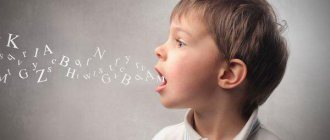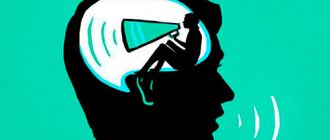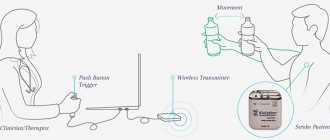Expressive and impressive speech in speech therapy
Speech activity of children is divided into 4 independent forms:
| Forms related to expressive speech | Forms related to impressive speech |
|
|
Expressive or motor speech is the process of a growing person producing specific sounds and letters using the mouth and vocal cords or writing skills. Broca's area, located in the left hemisphere in people with a dominant right hand, or in the right hemisphere in those who carry out everyday activities with the help of their left limb, is responsible for this function in the child's body.
In the presence of pathological processes or injuries to the brain center in question, children are physically unable to clearly express their thoughts, reproduce them on paper, while clearly understanding the task and information perceived aurally. The opposite of expressive speech is impressive, or sensory.
Its essence lies in the clear awareness by the brain centers of information perceived by a person through the organs of hearing or vision.
Wernicke's area is responsible for this function. If a child, as a result of an injury or due to a genetic disorder, has dysfunction in this area of the cerebral cortex (located in the left temple area), he cannot perceive words, since he does not understand their meaning and does not even identify the emotional coloring.
At the same time, his hearing organs function normally, which, when conducting a medical examination of the health status of a growing person, can provoke a misunderstanding by the pediatrician of the reasons for the significant developmental delay of a particular young patient.
In some cases, the child’s body adapts to physical “disadvantages”, compensating for them by making other senses of perception more developed.
Agraphia as a separate manifestation of expressive language disorder
Agraphia is the loss of the ability to write correctly, which is accompanied by preservation of motor function of the hands. It occurs as a consequence of damage to the secondary associative fields of the cortex of the left hemisphere of the brain.
This disorder becomes concomitant with oral speech disorders and is extremely rarely observed as a separate disease. Agraphia is a sign of a certain type of aphasia. As an example, we can cite the connection between damage to the premotor area and a disorder of the unified kinetic structure of writing.
In the case of minor damage, a person suffering from agraphia may correctly write specific letters, but may misspell syllables and words. It is likely that there are inert stereotypes and a violation of the sound-letter analysis of the composition of words. Therefore, such people find it difficult to reproduce the required order of letters in words. They may repeat individual actions several times that disrupt the overall writing process.
Functions
The stages of expressive speech are normally considered (in this order):
- Formation of a motive or the emergence of a desire to speak out.
- Reproduction of a formulated thought in the brain centers (coding the main idea in the speech patterns of the brain).
- Voicing a formulated statement.
Speech therapists include the most important functions of expressive speech:
- the opportunity to express one’s emotional state (a child’s inability to convey to others about his personal attitude towards the events taking place in his life is fraught with the occurrence of neuroses, depression, and mental disorders);
- simplification of the child’s adaptation period in the children’s group;
- the formation of a predisposition to rapid socialization (the ability to feel comfortable in society without the presence of parents).
Impressive speech in its psychological structure implies the presence of 3 main stages:
- Primary perception of information flow. It can reach the child both through the hearing organs and the speech system.
- Decryption of the received message. At this stage, the child's brain perceives the sound or letter composition of incoming information.
- Forming connections between the results of data analysis and knowledge stored in think tanks, or one’s own understanding of what was heard (read).
The correct development of impressive speech is necessary for the correct implementation of its key functions:
- the opportunity to be in society and feel like a full member of it (understand the rules, accept the requests of others, respond to requests, and so on);
Expressive and impressive speech may be poorly developed in children, leading to separation from peers. - the ability for self-development (broaden your horizons, expand your vocabulary, and so on);
- using past life experience to improve the quality of what is happening in the present (for example, a child who is unable to store memories in the subcortex may often get burned by a hot kettle. Not only does he not remember his negative experience, but he also cannot fully perceive the warnings of his parents).
Alternative interpretation of the term
The term “expressive speech” refers not only to the types of speech and the features of its formation from the point of view of neurolinguistics. It is the definition of the category of styles in the Russian language.
Expressive styles of speech exist in parallel with functional ones. The latter include bookish and conversational. Written forms of speech are journalistic style, official business and scientific. They belong to book functional styles. Conversational is represented by the oral form of speech.
Means of expressive speech increase its expressiveness and are designed to enhance the impact on the listener or reader.
The word “expression” itself means “expressiveness”. The elements of such vocabulary are words designed to increase the degree of expressiveness of oral or written speech. Often, several expressive synonyms can be selected for one neutral word. They may vary depending on the degree of emotional stress. There are also often cases when for one neutral word there is a whole set of synonyms that have exactly the opposite connotation.
The expressive coloring of speech can have a rich range of different stylistic shades. Dictionaries include special symbols and notes to identify such synonyms:
- solemn, high;
- rhetorical;
- poetic;
- humorous;
- ironic;
- familiar;
- disapproving;
- dismissive;
- contemptuous;
- derogatory;
- sulgaric;
- abusive.
The use of expressively colored words must be appropriate and competent. Otherwise, the meaning of the statement may be distorted or take on a comical sound.
Development is normal
Expressive and impressive speech in speech therapy are one of the key indicators of the general development and health of the child. Depending on the age of the young patient, the doctor, according to basic standards, identifies the need for correctional classes or consultations with specialized specialists (neurologist, psychiatrist, psychologist, neurosurgeon, and so on).
According to the generally accepted norm, by the age of 7-8 years, a child must master a number of expressive speech skills, including:
- hooting;
- bumming;
- laughter;
- cry;
- babble;
- imitation of sounds produced by parents;
- the ability to describe one’s thoughts descriptively, which appears at the age of 8-9 months. – 1.2 years (for example, instead of the specific word “dog”, children say “woof-woof”);
- vocabulary of at least 200 words (up to 2 years);
- the ability to formulate sentences consisting of at least 3 words (at 1.5 – 2 years);
- expansion of vocabulary at the age of 4-5 years (at this stage, the child’s active vocabulary should consist of no less than 1500-2000 words);
- active use of all parts of speech when expressing your thoughts;
- the ability to compose complex and complex sentences without lexical errors;
- mastering, understanding and using the grammatical rules of the native language in speech;
- mastering ethnic skills (accent, dialect).
Speech therapists manage to understand at what stage of development the impressive component of a particular child’s speech is by correlating the actual skills of the little patient with generally accepted norms.
Such as:
- response to speech addressed to them (occurs when the child reaches 6 months);
- the ability to relate what is heard to a specific image (for example, on a card or in the environment around the child);
- the ability to correlate an action shown by an adult with a related image (for example, if a parent imitates hitting nails with a hammer, the child must take out from a box with different tools exactly the working tool shown to the adult);
- understanding of vocabulary related to the description of actions and the quality of household items (colors, material, texture, size, etc.);
- the ability to implement instructions consisting of 2 or more stages;
- understanding the meaning of prepositions and conjunctions used in speech (for example, normally a child should not confuse “and” with “or” and so on);
- the ability to perceive fairy tales with the help of the organs of vision (up to 4 years), and later only with the help of the organs of hearing (from 4-5 years).
Sample work plan
The disorder is based on problems with all parts of speech. Therefore, at the first stage, it is important not only to practice sound pronunciation, but also to evoke any response speech. Even in the form of elementary onomatopoeia.
Be sure to develop the child’s perception. To do this, he is introduced to different materials. For example, they let you sort through cereals, beads, and sand. You can show fruits and vegetables, offering to smell, touch, and taste them.
The development of fine motor skills directly affects speech, since these two areas of the cortex are located nearby in the brain.
The more impressions there are in the baby’s life, the better. The main thing is not to overdo it. Excessive emotions provoke stuttering.
At the first stage, the speech therapist’s task is to create a desire to contact and interact. To do this, they use finger theater, toys and simple onomatopoeia, like “Who says what?”
In severe cases, children do not use the pointing gesture. In this case, they forcefully take the hand, fold their fingers and point at the toy or picture with the index finger.
The Novikova-Ivantsova technique has proven itself well. It is based on singing vowel sounds. With motor alalia, it is sometimes difficult for children to make a certain arrangement of the organs of articulation. In this case, it is done forcibly. The adult uses his fingers to purse his lips and move the child’s jaw.
Don't be afraid of crying or other negative emotions. This is a normal reaction due to the immaturity of the cerebral cortex.
After you manage to get the first words, you need to try to build phrases. For example, showing a picture and saying: “Mom, go.” Be sure to achieve not only the reproduction of the phrase, but also the understanding of what was said.
The child must be able to correlate the image and the phrase. Only then will his speech develop. Work is definitely underway to practice sound pronunciation. To begin with, they work on the sounds of early ontogenesis: vowels, back-lingual (“K”, “G”, “X” and soft pairs), labials (“V”, “F” and others).
Articulation gymnastics in front of a mirror is mandatory. From the first lessons, the speech therapist teaches the child to control himself. Only after this will you be able to achieve results.
Correctional work to eliminate expressive speech disorder lasts 2-3 years. In severe cases, it takes up to five years. Parents also need help, since only they are able to conduct classes every day and do homework with the child.
Sometimes at school age there may be difficulties with writing and reading, which are expressed in specific errors. In this case, a speech therapist will help.
Delayed development
Expressive and impressive speech in speech therapy can develop in children with delay due to:
- existing perinatal damage to the brain centers (pathologies that occur while the child is in the womb);
- birth as a result of premature birth;
- disturbances in the functioning of the organs of articulation;
- underdevelopment of the hearing aid or serious diseases of its main organs;
- existing general mental retardation of a particular child;
- genetic predispositions (can be transmitted through several generations);
- lack of sufficient communication with close relatives (psychologists have proven the need for daily communication with children from the first day of their life. Despite the lack of response on their part to addresses and words, during the perception of the mother’s speech, the brain center responsible for impressive speech is actively formed);
- lack of proper education (relevant for children under the care of municipal orphanages or infant homes);
- existing delay in physical development;
- the presence of serious diseases affecting the nervous system and brain that the child suffers in early childhood;
- lack of a complete balanced diet in the first years of life;
- autism;
- deficiency of stimulating factors of speech development.
Expressive and impressive speech, which develops with a delay, are recognized in speech therapy by a number of signs:
- incorrect pronunciation of words (rearrangement of letters, distortion of sounds, etc.);
- inappropriate use of prepositions and conjunctions;
- absence of interrogative sentences in the child’s speech;
- pauses between words longer than 2 seconds;
- stuttering;
- not saying parts of a word.
Disorders
Expressive and impressive speech in speech therapy, namely the level of its development in a particular young patient, determines the direction of additional classes designed to adapt the child to age-related psychological and physiological changes. For the convenience of providing assistance to children, speech therapists decided to classify speech disorders into subtypes.
Having different views on the course of therapy, specialists have so far failed to come to a common decision. Despite the presence of many options, the most popular of them is the classification of L. O. Badalyan.
Associated with serious disturbances in the functioning of the central nervous system
According to Badalyan, it is advisable to classify lesions of the child’s nervous system at the stage of intrauterine development or after the birth of a child into several forms.
For example:
| Form of speech disorder | a brief description of |
| Aphasia | With this type of disorder, the child experiences a breakdown of the maximum number of speech components. This dysfunction occurs due to significant damage to the cortical language areas of the brain. |
| Alalia | In the presence of the speech disorder in question, the developmental delay of a particular person occurs according to a pattern similar to aphasia. The only difference is that alalia occurs at the stage of pre-speech development. |
| Dysarthria | It occurs due to insufficient development of the muscles of the speech organs. If dysarthria is present, the child cannot correctly compose and voice his thoughts. Depending on which area of the brain was affected, speech therapists classify dysarthria into:
Each form of speech disorder requires taking special measures to eliminate it. |
Associated with minor changes in the functioning of the central nervous system
Forms of speech disorder arising due to functional deformations of the central nervous system are:
- stuttering (when voicing one word, the child repeats the same compound syllable several times);
- mutism (the child does not respond to requests from other people and does not react to what is happening);
- surdomutism (the child is unable not only to perceive information by ear, but also to reproduce it independently).
Associated with deviations in the structure of the organs of the articulatory apparatus
The forms of speech disorders provoked by the imperfect structure of the organs of articulation are considered to be:
- mechanical dyslalia (the child does not pronounce sounds or deliberately distorts them due to the lack of physical ability to pronounce them correctly, for example, in the presence of a short frenulum of the tongue);
- rhinolalia (the child does not pronounce nasal sounds due to the incorrect structure of the ENT organs).
Various origins
Speech therapists include speech disorders of various origins as delays in the development of a child’s speech for non-physiological reasons:
- birth as a result of premature birth;
- the presence of serious diseases of the internal systems of the body;
- incorrect form of education and general development.
Diagnosis differentiation
Expressive language disorder refers to several possible illnesses. They go under the code F80.1. First of all, this is the actual delay in speech development (SDD). Expressed in the absence of speech or its insufficient level.
The next thing is motor alalia. This is a serious violation that should not be confused with ZRR. It affects specific areas of the cerebral cortex and is visible on MRI. In the case of ZRD, we are talking about the immaturity of the nervous system, but it is successfully overcome and, to some extent, partially eliminates itself.
Another diagnosis that is included in this group is aphasia, that is, speech breakdown. It occurs due to stroke, head injuries and serious illnesses (tumors, meningitis). In children, this disorder is rarely detected. It can appear only closer to school age. Such a disorder will also be visible on MRI, since the cerebral cortex is affected.
It is not always easy to separate mutism from delay. This problem is characterized by normal speech development, but a complete reluctance to use it. This happens for various psychological reasons. Most often, the child agrees to communicate only with certain people, for example, with the teacher. He doesn't use the pointing gesture.
Hearing and intellectual impairments must be excluded. With these disorders, speech may be limited to simple imitation or completely absent.
Some specialists make a diagnosis of LDRD - delayed psycho-speech development. According to neurologists, such a concept does not exist. The child must have either mental development disorder or mental development delay (MDD).
Correction
Correcting delayed development of expressive and impressive speech requires an integrated approach.
The specific set of measures taken is determined by the speech therapist, taking into account the actual data of a particular small patient:
- nootropic drugs (stimulate the activity of cells in the cerebral cortex, which improves memory in children, enhances attention, the ability to concentrate, normalizes sleep and general mental state, and so on);
- physiotherapeutic procedures (for example, microcurrent therapy, which involves the active impact of minimal current discharges on biologically active areas of the cerebral cortex);
- developmental classes with a speech therapist and defectologist (specialists focus their efforts on improving the little person’s memory and general development of thinking);
- speech therapy massage (a complex effect on the facial muscles, promoting the development of speech in a small person);
- performing play-based exercises aimed at developing facial muscles (for example, “Clock”, in which a 2-3 year old child needs to stick out his tongue and move it from side to side; onomatopoeic exercises (imitation of rain, animal voices, etc.) or voicing poems (the adult shows - the child voices his actions, after which the roles change).
Expressive and impressive speech should normally be developed in children at a basic level by the age of 4-5 years. In speech therapy, there are a large number of ways to stimulate a child’s ability to correctly express his thoughts, which he can practice not only with a specialist, but also at home alone with his parents.
Despite the importance of the speech aspect in the overall development of a growing person, adults are not recommended to put moral pressure on the child and force him to study. Instead, you should talk to him as much as possible, take an interest in the child’s opinion and expand his horizons.
Diagnostics
It is important to show a child with any speech disorders to a pediatrician: he will examine him, ask the parent questions and refer him to more specialized specialists : a pediatric neurologist, otolaryngologist, speech therapist, psychologist.
The main purpose of the examination is to determine the causes of the disorder, distinguish it from similar disorders and determine the optimal treatment tactics.
The diagnostic process consists of:
- General examination. Specialists talk with parents, study the anamnesis, find out whether there were any violations during the process of bearing the child and during childbirth. Reflexes are also tested. After this, the child is sent for additional examinations, the list of which depends on the conclusions of specialists. As a rule, this list includes electroencephalography, MRI or CT scan of the brain.
- Examination by a speech therapist. The speech therapist determines how deep the speech disorders are using tests, talks with the child, notices how well he controls his own articulatory apparatus, how he uses words and constructs sentences.
- Diagnostics of the mental sphere. Checks are carried out by a child psychologist in the form of a game. He monitors the child’s behavior and communicates with him. The child also undergoes tests that determine the degree of development of his cognitive abilities and intelligence quotient.
After a comprehensive examination, a diagnosis is made. The sooner correction of the disorder is started, the more favorable the prognosis will be.










